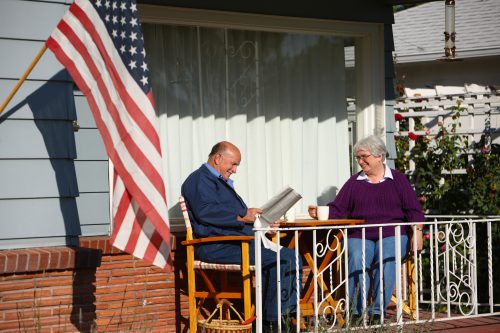
CWP Blog | CWP
Safety Proofing Your Home: Top Tips to Age in Place Safely
April 9, 2025
April 9, 2025
CWP
CWP Blog
Without a doubt, most people would prefer to age in the residence that they’ve likely called home for years. This common desire is referred to as “aging in place.” No one wants to be forced from their home for any reason, let alone because of health or mobility issues.
Yet, it’s at home where many falls and other mishaps occur — especially with age — making the place where we feel most comfortable a dangerous place. By walking through your house and conducting a thorough audit, you can easily identify the most common dangers, as well as possible solutions. If you have a history of falls, your healthcare provider might also suggest that you work with an occupational therapist or in-home care specialist to help assess your home’s safety and make recommendations for change.
Many safety modifications for your home are affordable and easy to do yourself. Even better, if you or someone in your home has qualified for a U.S. Department of Labor (DOL) medical benefits white card through the Energy Employees Occupational Illness Compensation Program Act (EEOICPA), you may discover that larger home renovations and upgrades necessary to accommodate your symptoms of a covered illness may be covered or reimbursable.
Trips and Slips
A study conducted by the Centers for Disease Control and Prevention (CDC) found that 28.7% of adults over the age of 65 reported falling at least once in the last 12 months. Another study by the Hospital for Special Surgery found that roughly 60% of falls happen at home.
You don’t need to become one of these statistics. There are some simple and inexpensive fixes that you can make to reduce your risk of tripping or slipping at home, including:
- Clean up walkways (inside and out) and don’t accumulate clutter.
- Don’t use throw rugs or small area rugs because they can bunch up under a walker or cane.
- Clean up spills immediately.
- In the winter, treat outdoor walkways with an ice-melt product or sand.
- Keep electrical cords near walls and away from walking paths.
- Arrange your furniture, like low coffee tables, and other objects so they are not in your way.
- Don’t let your cat or dog trip you. According to the CDC, more than 86,000 fall injuries per year are associated with cats and dogs. Know where your pet is whenever you’re standing or walking and put a bell on them, if necessary.
- Wear nonslip footwear (slippers and shoes), preferably with a closed heel to prevent the shoe from coming off.
- If you have steps leading to your front door, make sure they are not broken or uneven.
- Consider installing a grab bar near the front door to provide balance while you are locking or unlocking the door.
- Clearly mark any thresholds that have an uneven transition between rooms.
Insufficient Lighting
For many people, vision gets worse with age. That’s why having sufficient lighting inside and outside the home is so important. Enhancing the lighting in your home doesn’t need to be expensive. Nor does it necessarily require the skills of an electrician or a complete rewiring of your home.
An easy fix is to install LED light bulbs which provide greater brightness and last longer. Adding dimmer switches can help adjust the light you need for various tasks and rooms. Cataracts, for example, can cause light sensitivity, so you may need dimmer light in some areas of the home.
Motion-detecting lights are great for interior and exterior use if you don’t want to worry about using switches or remotes to light up the space.
Specific areas of your home worth adding extra lighting, even smaller night lights, include:
- The top and bottom of stairs.
- Long halls, especially if they lead to the bathroom you’ll use at night.
- Inside the bathroom.
- Area near your bed. Plus, keep a flashlight near your bed in case of power outages.
- Turn on your porch light at night, or even during the day if you don’t plan on returning until evening.
If you have steps in your home, you may also want to consider adding bright contrast tape to stairs and uneven parts of the floor.
Losing Your Balance
As you age, there are other reasons you may be more likely to fall, even with sufficient lighting and no tripping or slipping hazards. That’s because many age-related health issues can impact your balance, including an array of circulatory problems and heart disease. Both can cause numbness and pain which may make it harder to remain steady on your feet. Certain medications are also known to cause dizziness or imbalance.
To limit the risk of falling from a balance issue:
- Ensure there are secure handrails on both sides of stairs.
- Mount grab bars near toilets and on both the inside and outside of your tub and shower. A study published in the Injury Epidemiology Journal reported that falls occurring in the bathroom are more than twice as likely to result in an injury compared to falls occurring in the living room.
- Invest in a walk-in tub.
- Add nonslip gripping material to the shower or tub floor.
- Make sure your sofas and chairs are the right height for you to get in and out of easily.
- Prepare food while seated to prevent fatigue or loss of balance.
Out of Reach
Sometimes all it takes to make your home and daily routines safer is to plan better and keep commonly used items in easy reach. Stretching too far or standing on a ladder or stool introduce their own safety risks.
Here are some pointers for keeping the things you need safely close by and avoiding the extra reach:
- Place a landline or well-charged phone near your bed.
- Keep items you use often at waist level or within easy reach, including medicines, certain pots, pans and cooking utensils.
- Don’t stand on a chair or table to reach something that’s too high. Use a “reach stick” or ask someone else for help.
- Invest in a sturdy, quality step stool.
- With arthritis and other joint problems, it can be difficult to grip certain handles or turn knobs. “D”-shaped handles are known for being the easiest to use because you don’t need to grip them to open them.
Fires and Risks of Burns
As we age, our skin becomes more likely to be hurt by heat. If you’ll be taking hot showers or using hot water in the kitchen, consider reducing the temperature setting on your hot water heater to prevent burns.
Surviving a fire is more challenging for anyone with mobility issues. Some simple tips for reducing fire risks include:
- Install and ensure the continuous, reliable operation of smoke and carbon monoxide detectors with audible and visual alerts. There are also alarms with non-replaceable batteries which last up to 10 years, which can be great for anyone who often forgets to check their batteries.
- Check appliances for frayed cords.
- Avoid wearing long sleeves or extra loose clothing when cooking.
- Don’t trap electrical cords under bedding or against walls where heat can build up.
- Keep bedding, clothes, curtains, and other combustible items away from space heaters, and only use lab-approved electric blankets and warmers.
Covered Expenses
As part of the many benefits under EEOICPA, U.S DOL medical benefits white card holders are eligible for reimbursement for medically needed home or vehicle modifications that help cardholders to age in place at home, if the limitations or symptoms are directly related to a covered illness. So larger things like ramps, walk-in tubs, and stairlifts could be paid for under EEOICPA.
Cold War Patriots is Professional Case Management’s free membership organization providing recognition and resources to nuclear weapons and uranium worker communities by connecting them with the monetary compensation and health benefits they have earned. If you’re interested in aging in place, one of our local representatives can review the safety of your home and assist with determining how to reduce safety risks. To discuss your options for an in-home safety assessment and EEOICPA benefits, call Cold War Patriots today at 855-230-1339 or email us at [email protected].
